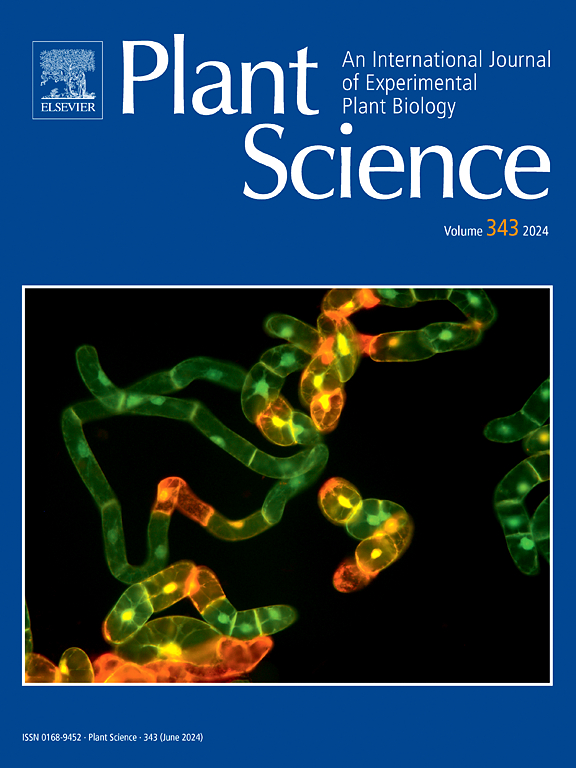Investigation of wheat cold response pathway regulated by TaICE41 and TaCBFⅣd-B9 through Brachypodium distachyon transformation
IF 4.2
2区 生物学
Q2 BIOCHEMISTRY & MOLECULAR BIOLOGY
引用次数: 0
Abstract
Wheat (Triticum aestivum L.), a major global crop, is vulnerable to freezing stress, particularly during late spring frosts. Enhancing freezing tolerance through cold acclimation, primarily via the ICE-CBF-COR pathway, is crucial for improving wheat productivity. This study focuses on identifying genes regulated by the ICE-CBF pathway and those that function independently in response to freezing stress. TaICE41 and TaCBFⅣd-B9, two key genes associated with cold tolerance, were cloned and analyzed for their phylogenetic characteristics and subcellular localization. Transgenic Brachypodium distachyon overexpressing these genes demonstrated enhanced freezing tolerance, with increased survival rates and proline content, compared to wild-type plants. RNA-seq analysis revealed distinct gene expression profiles under cold stress, highlighting both shared and unique pathways regulated by ICE41 and CBF. Notably, the TaICE41-overexpressing lines exhibited upregulation of genes involved in phenylpropanoid biosynthesis and starch-sucrose metabolism, contributing to stress response. This study provides new insights into the ICE-CBF pathway and its role in cold tolerance, emphasizing the importance of understanding both ICE-CBF-regulated and independent cold-responsive genes for improving freezing tolerance in crops.
TaICE41和TaCBFⅣd-B9调控小麦冷响应途径对短柄草远端子转化的研究
小麦(Triticum aestivum L.)是一种主要的全球作物,易受冰冻胁迫,特别是在晚春霜冻期间。通过冷驯化(主要通过ICE-CBF-COR途径)增强抗冻性对提高小麦产量至关重要。本研究的重点是鉴定受ICE-CBF通路调控的基因和那些在冰冻胁迫下独立起作用的基因。克隆了两个与耐冷性相关的关键基因TaICE41和TaCBFⅣd-B9,并对其系统发育特征和亚细胞定位进行了分析。与野生型植物相比,过表达这些基因的转基因短茅具有更强的抗冻性、更高的存活率和脯氨酸含量。RNA-seq分析揭示了寒冷胁迫下不同的基因表达谱,突出了ICE41和CBF共同和独特的调控途径。值得注意的是,taice41过表达系表现出与苯丙素生物合成和淀粉-蔗糖代谢相关的基因上调,有助于应激反应。这项研究为了解ICE-CBF通路及其在抗寒性中的作用提供了新的见解,强调了了解ICE-CBF调控的和独立的冷响应基因对提高作物抗寒性的重要性。
本文章由计算机程序翻译,如有差异,请以英文原文为准。
求助全文
约1分钟内获得全文
求助全文
来源期刊

Plant Science
生物-生化与分子生物学
CiteScore
9.10
自引率
1.90%
发文量
322
审稿时长
33 days
期刊介绍:
Plant Science will publish in the minimum of time, research manuscripts as well as commissioned reviews and commentaries recommended by its referees in all areas of experimental plant biology with emphasis in the broad areas of genomics, proteomics, biochemistry (including enzymology), physiology, cell biology, development, genetics, functional plant breeding, systems biology and the interaction of plants with the environment.
Manuscripts for full consideration should be written concisely and essentially as a final report. The main criterion for publication is that the manuscript must contain original and significant insights that lead to a better understanding of fundamental plant biology. Papers centering on plant cell culture should be of interest to a wide audience and methods employed result in a substantial improvement over existing established techniques and approaches. Methods papers are welcome only when the technique(s) described is novel or provides a major advancement of established protocols.
 求助内容:
求助内容: 应助结果提醒方式:
应助结果提醒方式:


